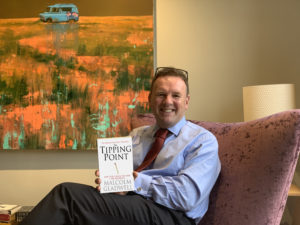 What makes a hit? How do brands and their products reach that critical mass that takes them from just doing ok (or not even managing that) to exploding into the public consciousness?
What makes a hit? How do brands and their products reach that critical mass that takes them from just doing ok (or not even managing that) to exploding into the public consciousness?
In The Tipping Point, Malcom Gladwell unpicks the key ingredients that go into achieving a runaway success. Just like the science of epidemics, to achieve a ‘tipping point’ – the moment at which an idea, trend or behaviour spreads like wildfire, requires the coming together of certain key ingredients and conditions.
What makes it great, in a nutshell?
Success can seem like black magic at times – some things just end up being really successful, while others, despite all our best efforts, don’t. This book isn’t a recipe for a viral hit, but it does give a great insight into the conditions required for the perfect storm.
Working through the book – three basic laws
The book opens with the parable of Hush Puppies, the once decidedly uncool footwear brand that suddenly found itself in huge demand. Back in the mid 90s, Hush Puppies were on the brink of extinction, but then something odd happened. They began to hear reports of fashion-conscious influencers in Soho actively seeking out whoever was still selling them. The influencers led to designers, manufacturers and ultimately, buyers catching on and by 1996 sales were in the millions. The message might read as “hope some influencers start making your product cool”, but the takeaway is to put time and resources into finding out who your influencers are.
Gladwell sets out three key types of influencers – ‘Mavens’, ‘Connectors’ and ‘Salesmen’. Mavens are trusted, opinion-leading experts who pass knowledge on to others. Connectors are highly influential social networkers who people will listen to and Salesmen of course, sell us the product. In short, a small group of people can hold the key to influencing everyone else, so it’s important to identify your influencers, engage them, and get them on board.
But people aren’t enough on their own. In the chapter ‘The Stickiness Factor’ Gladwell explains that an idea, product, or message must be intriguing, memorable, or addictive – ‘sticky’. It’s the quality that compels people to pay sustained attention, it’s hard to pin down – like defining ‘charisma’ – and it’s often unconventional or unexpected. In 1978, Lester Wunderman used a ‘treasure hunt’ campaign to capture the attention of Colombia students that was very different from the normal saturation campaigns; repeated attempts to tell college students about free tetanus shots fell on deaf ears until their college printed booklets with a campus map and the health office’s hours – the Stickiness Factor.
It’s worth thinking long and hard about how we get our message across in a way that ‘sticks’ in the memory. It’s also important to grasp that it may take several attempts to find the right direction, Gladwell argues that successes are often the reward for those who are willing to try and fail along the way.
The third key ingredient is what Gladwell terms the ‘Power of Context’. He argues that small variations in social groups, or creating minor changes in an environment can cause a new idea to ‘tip’. In the 1980s, New York crime rates plummeted, not because of a period of bonhomie, but because of a campaign by the city to clean up the subway. They began removing graffiti from trains and targeting fare-dodgers. This ‘Broken Windows Theory’ shows us an exercise in changing perceptions – no laws altered, the people had the same personalities as before, but they were less likely to commit crimes, because their environment didn’t encourage these crimes anymore.
What does the book teach us?
The Tipping Point isn’t a conventional business book – it’s more of a deep dive into psychology and sociology, but there are some key takeaways. Most importantly, deliberately seeking out ‘the few’ – the influencers that could create your tipping point – who are the gateway to the many. The footwear brand Airwalk did a great job of mirroring innovator trends in its adverts, but later failed because it lost touch. We need to maintain contact with the people who really matter.
But there’s also a message about persistence. As Edison once said, “many of life’s failures are people who did not realise how close they were to success when they gave up”. Like the conditions for life itself, a tipping point is a balancing act – the right people, the right message (and the right way to pass it on), in the right place at the right time.
The Tipping Point certainly isn’t an instruction manual, but it pulls back the curtain on success to show that far from being witchcraft, it’s a science – albeit a tricky one.
Categories: Business Owners, Business Planning, Entrepreneurs, Financial Planning




